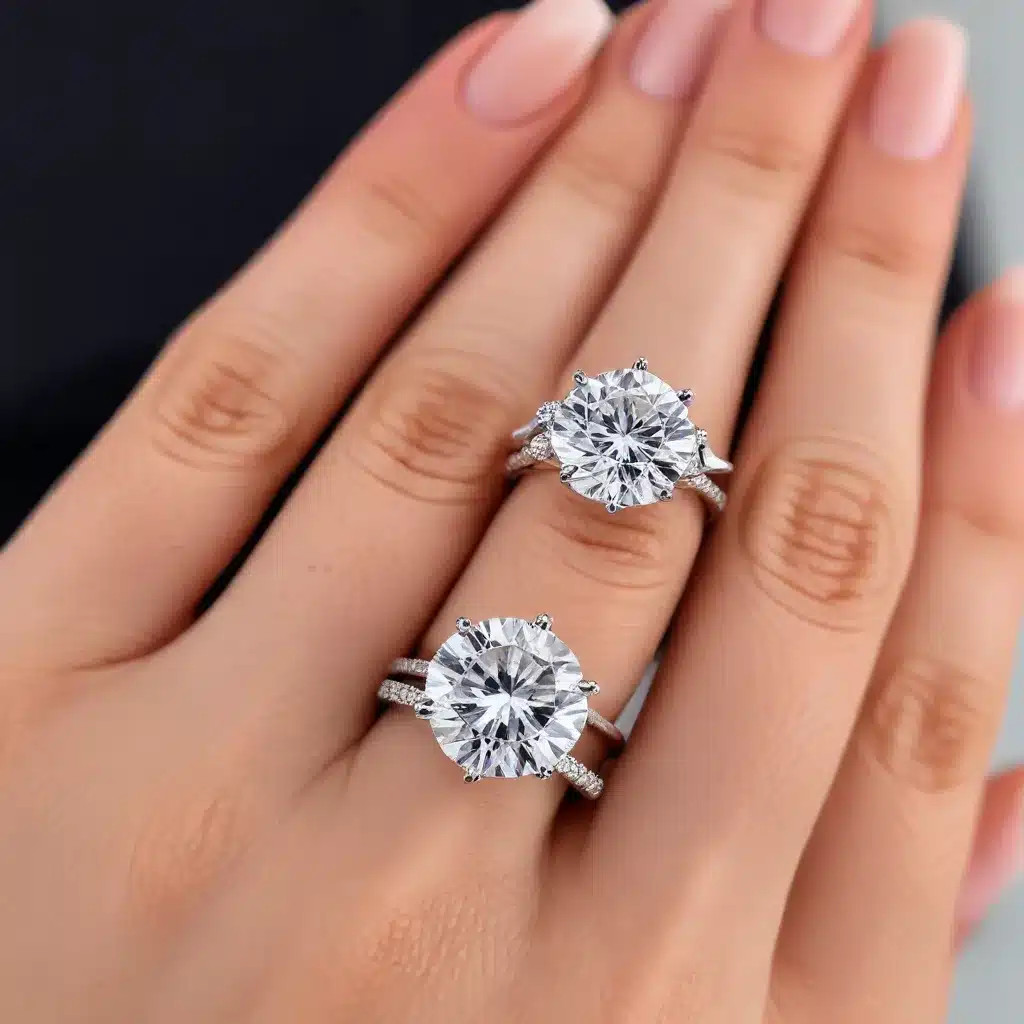
Moissanite and cubic zirconia are two of the most popular diamond alternatives in the world of gemstones. Both offer unique properties and characteristics that make them attractive options for jewelry and various other applications. As a gem and jewelry expert writing for Shelby Gem Factory, I’ll delve into the intricacies of these synthetic gemstones, exploring their origins, optical brilliance, durability, and the factors that set them apart.
Gemstone Attributes
Optical Properties
Refractive Index and Dispersion: Moissanite boasts a higher refractive index (2.65-2.69) compared to cubic zirconia (2.15-2.18), resulting in more intense fire and brilliance. This difference in refractive index also contributes to moissanite’s higher dispersion value (0.104), which manifests as more vivid flashes of color when the stone is moved in light.
Sparkle and Brilliance: The higher refractive index and dispersion of moissanite give it a more captivating sparkle and brilliance that can outshine even natural diamonds. Cubic zirconia, while still highly reflective, exhibits a more subdued sparkle due to its lower optical properties.
Physical Characteristics
Hardness: Moissanite’s exceptional hardness, measured at 9.25 on the Mohs scale, makes it one of the hardest materials known to man. This remarkable durability makes moissanite highly resistant to scratches and daily wear. In comparison, cubic zirconia, with a Mohs hardness of 8-8.5, is softer and more prone to scratching over time.
Clarity and Color: Both moissanite and cubic zirconia can be found in high-clarity, near-colorless varieties. However, moissanite may exhibit a slight yellow or gray hue, while cubic zirconia is typically more colorless.
Chemical Composition
Moissanite: A lab-created gemstone made from silicon carbide (SiC), a naturally occurring mineral first discovered in a meteorite crater by Nobel Prize-winning chemist Henri Moissan in 1893.
Cubic Zirconia: A fully synthetic gemstone composed of zirconium dioxide (ZrO2), created through a high-temperature process known as the “skull melt” method.
Moissanite Examination
Origin and Synthesis
Moissanite’s intriguing history begins with its serendipitous discovery in a meteorite crater in Arizona. While initially mistaken for diamond, further analysis revealed it to be a new mineral, which was later named “moissanite” in honor of its discoverer. Today, moissanite is primarily produced in laboratories, utilizing advanced technology to create the sparkling crystals used in jewelry and other applications.
Optical Brilliance
The exceptional optical properties of moissanite, including its high refractive index and dispersion, contribute to its dazzling brilliance and fire. This remarkable sparkle can often surpass that of natural diamonds, making moissanite a highly sought-after diamond alternative.
Durability and Hardness
Moissanite’s hardness of 9.25 on the Mohs scale places it just behind diamond in terms of durability. This exceptional hardness ensures that moissanite can withstand the rigors of daily wear and tear, maintaining its pristine appearance over time.
Cubic Zirconia Examination
Origin and Synthesis
Cubic zirconia, on the other hand, is a completely synthetic gemstone, first created in the laboratory in 1937. Through the “skull melt” process, zirconium dioxide is heated to extremely high temperatures, resulting in the formation of clear, cubic crystals that closely resemble natural diamonds.
Optical Brilliance
While cubic zirconia shares some optical similarities with diamonds, its refractive index and dispersion values are lower than those of moissanite. This translates to a more subdued sparkle and fire compared to the dazzling effects of moissanite.
Durability and Hardness
With a Mohs hardness of 8-8.5, cubic zirconia is softer and more susceptible to scratches and damage over time. However, it still maintains a relatively high level of durability, making it a suitable option for everyday jewelry wear.
Comparative Analysis
Cost and Value
Cubic zirconia is generally the more affordable option, making it an attractive choice for budget-conscious consumers. Moissanite, while more expensive than cubic zirconia, is still considerably less costly than natural diamonds, offering a more accessible high-quality alternative.
Ethical Considerations
Both moissanite and cubic zirconia are considered ethical and sustainable gemstone choices, as their production does not involve mining or other environmentally harmful practices. This makes them appealing options for those seeking more eco-friendly jewelry alternatives.
Sustainability and Environmental Impact
The manufacturing processes for both moissanite and cubic zirconia are generally more environmentally friendly than the extraction and processing of natural diamonds. This further enhances their appeal as responsible gemstone options.
Applications and Usage
Jewelry and Accessories
Moissanite and cubic zirconia are versatile gemstones that can be used in a wide range of jewelry designs, from engagement rings and necklaces to earrings and bracelets. Their adaptability allows for the creation of stunning, affordable pieces that cater to various personal styles and preferences.
Industrial and Technical Applications
Beyond the jewelry industry, moissanite and cubic zirconia also find applications in various industrial and technological fields, such as cutting tools, electronics, and optics, where their unique properties can be leveraged.
Personal Preference and Perception
The choice between moissanite and cubic zirconia ultimately comes down to personal preference and perception. While moissanite may be perceived as the more premium option due to its exceptional brilliance and durability, cubic zirconia’s affordability and diamond-like appearance make it a compelling alternative for those on a tighter budget.
In conclusion, moissanite and cubic zirconia are both remarkable synthetic gemstones that offer unique advantages and considerations for those seeking diamond alternatives. Moissanite’s superior optical properties, hardness, and rarity make it a captivating choice, while cubic zirconia’s affordability and versatility appeal to a broader range of consumers. Ultimately, the decision between these two gemstones depends on individual preferences, budget, and the desired aesthetic and practical needs. Whether you’re in the market for an engagement ring, a piece of everyday jewelry, or an industrial application, both moissanite and cubic zirconia present compelling options that are worth exploring.

